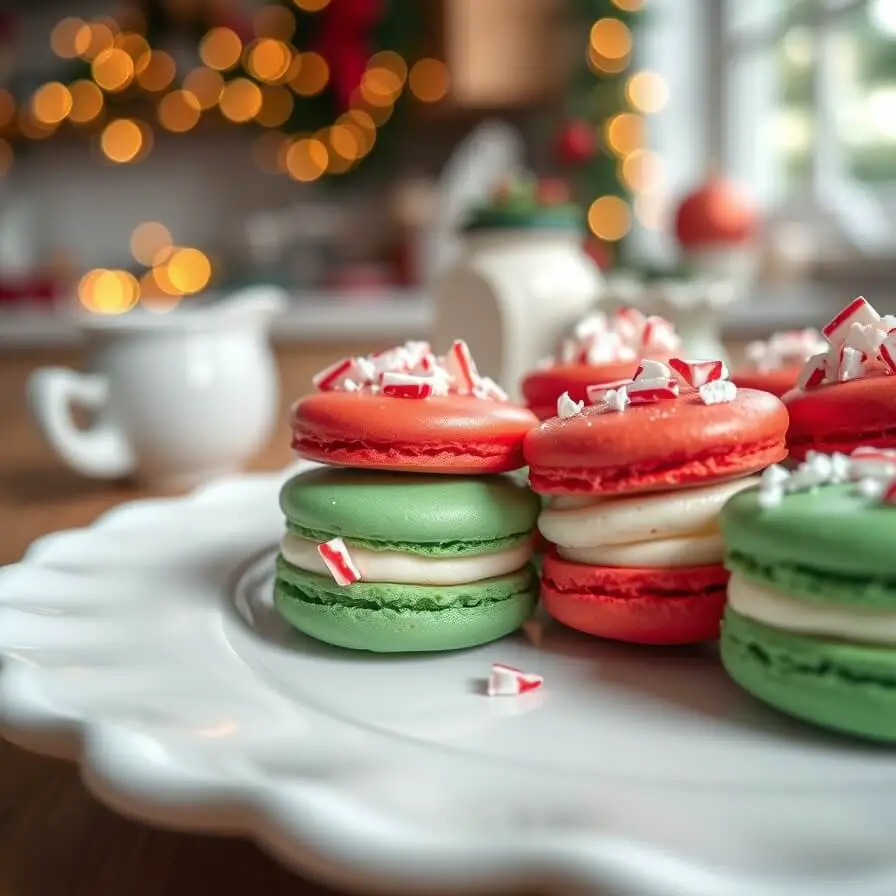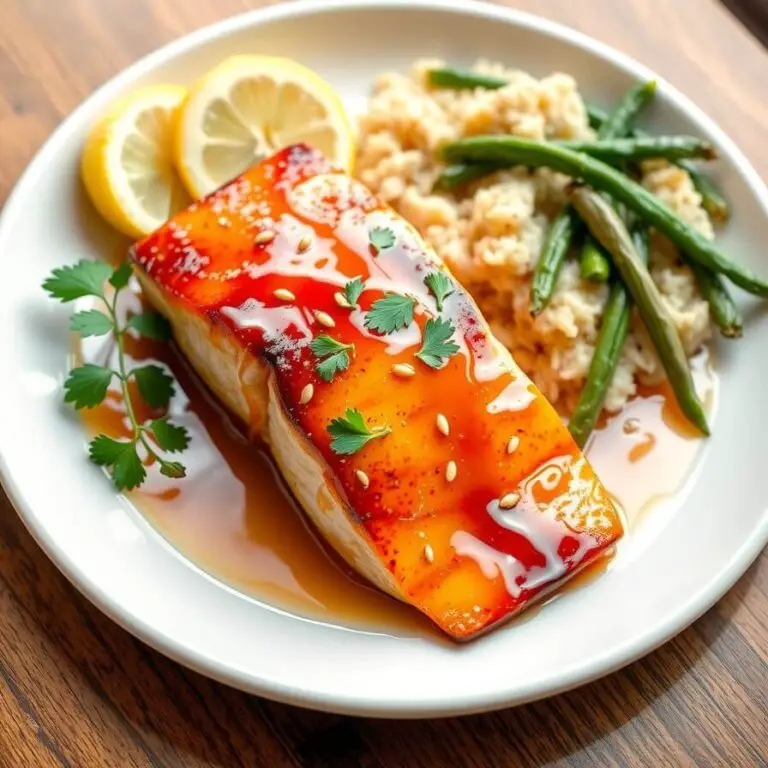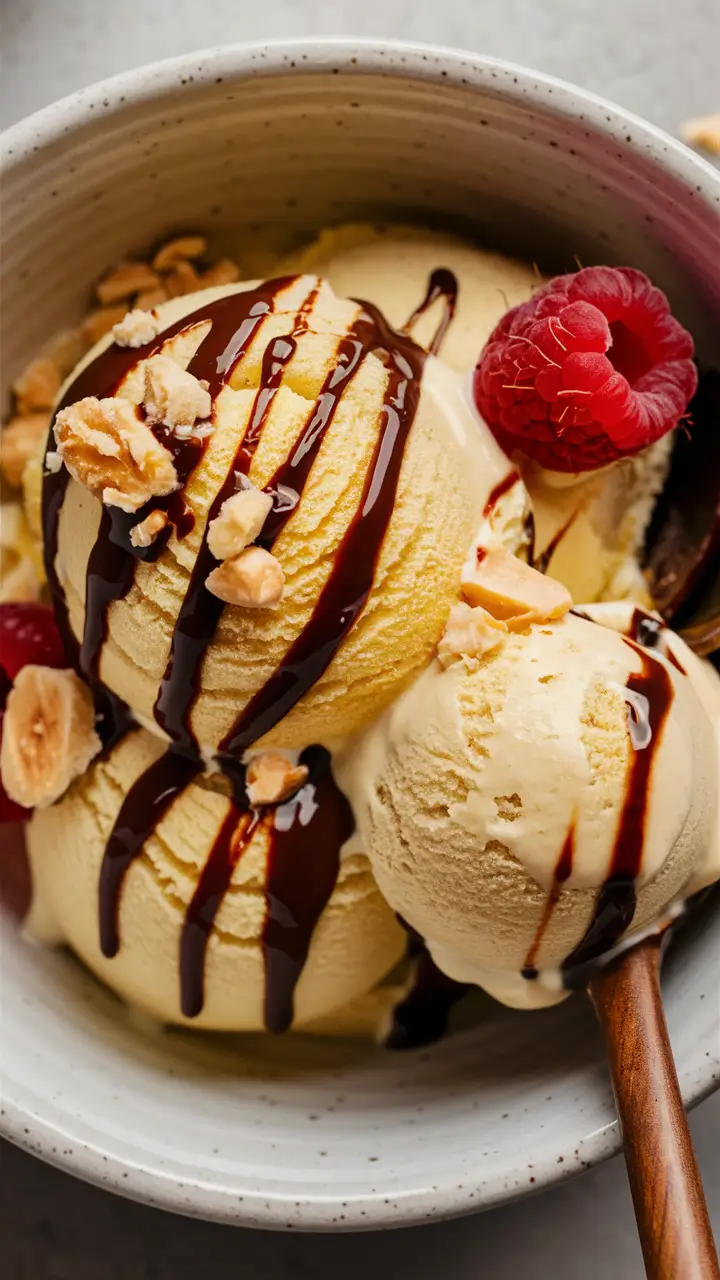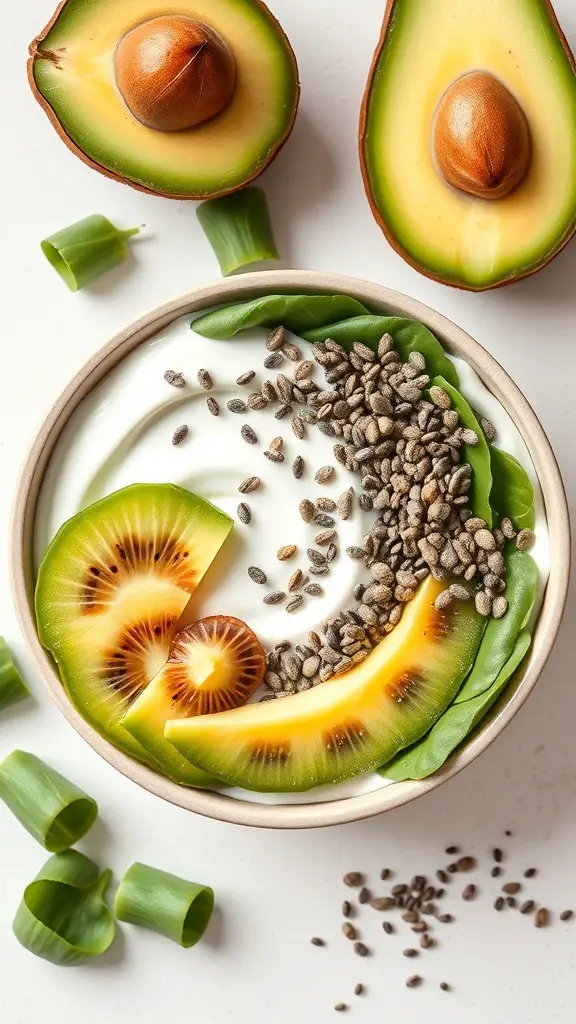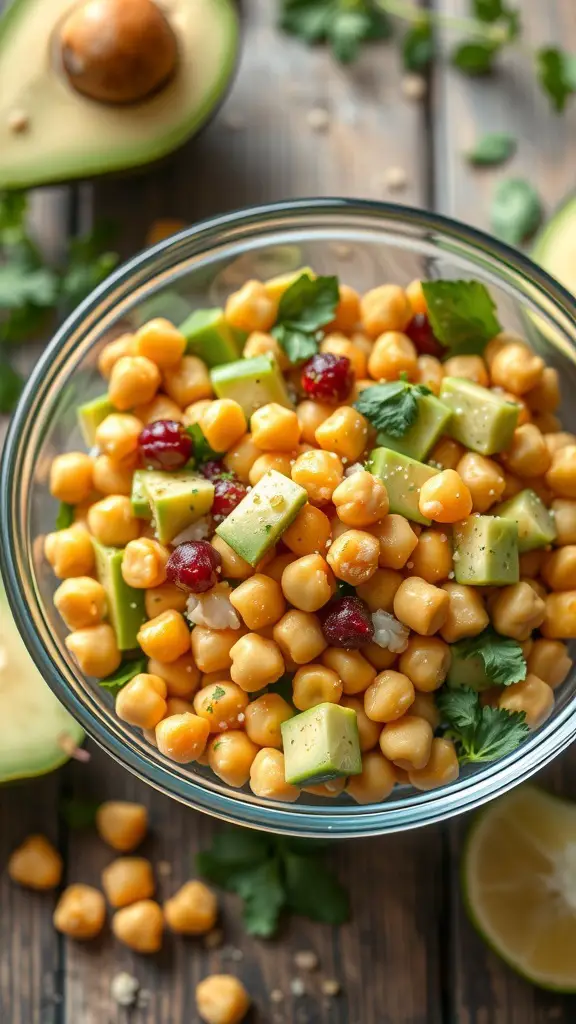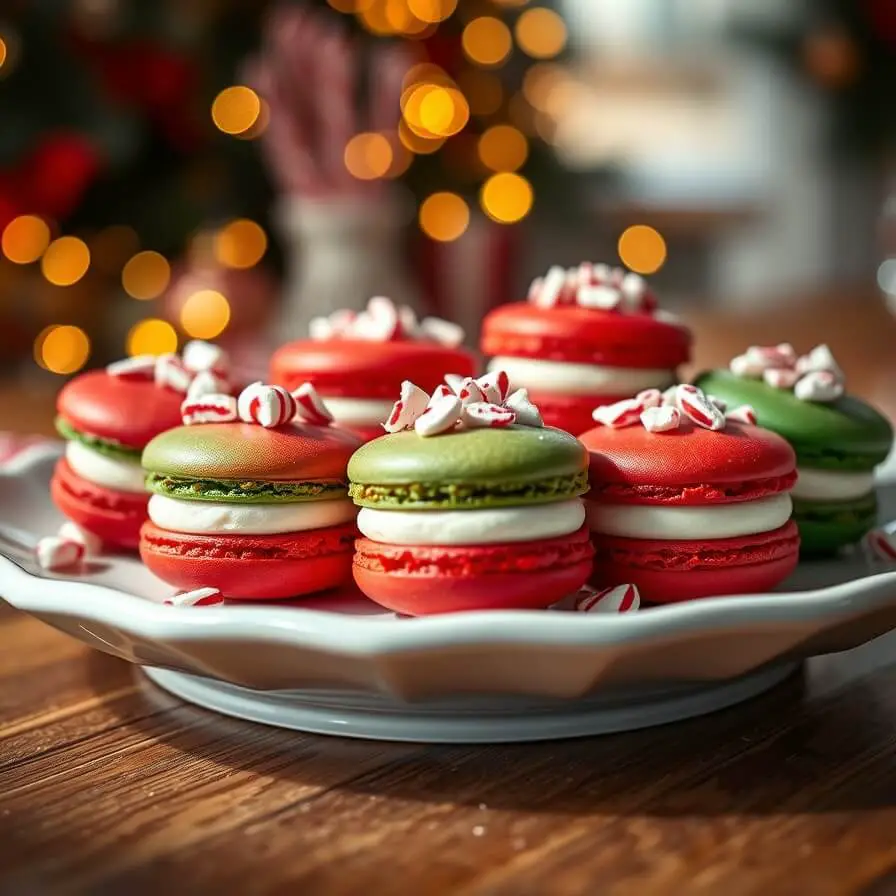
Every December, I find myself back in the kitchen with Christmas music humming softly in the background, the scent of vanilla and sugar filling the air. There’s something magical about this time of year — maybe it’s the twinkle of lights outside, or the way my family gathers around the counter to “taste test” before the cookies even cool.
A few years ago, I decided to tackle something I’d always admired but never dared to try: Christmas macarons. Those delicate, colorful French cookies always looked too perfect, too precise. But after a few attempts (and a lot of cracked shells), I finally found a recipe that captures the spirit of Christmas — crisp almond shells, lightly chewy in the center, filled with creamy peppermint buttercream and a hint of white chocolate.
Now, making them has become a family tradition. My daughter helps sprinkle crushed candy canes on top while my husband “supervises” with a mug of cocoa. These macarons aren’t just beautiful — they’re a festive treat that feels like Christmas wrapped in a cookie.
If you’ve ever wanted to make a holiday dessert that impresses without feeling impossible, these Christmas macarons are the perfect place to start.
Why I Love This Recipe
What makes this recipe so special is how it turns something sophisticated into something joyful and homey. Macarons are often seen as intimidating — the kind of dessert reserved for fancy patisseries. But the truth is, once you understand the rhythm of the process, they’re incredibly satisfying to make at home.
These Christmas macarons bring together the classic French almond meringue technique with festive holiday flavors. The peppermint buttercream adds a cool, creamy contrast to the sweetness of the shells, and the candy cane dust on top gives them a subtle crunch that makes each bite a little surprise.
I also love how customizable they are. If peppermint isn’t your thing, you can swap in white chocolate ganache, cranberry cream, or even a gingerbread spiced filling — and they’ll still feel perfectly Christmassy.
Another reason this recipe holds a special place in my heart: it’s a labor of love that brings people together. There’s something deeply satisfying about watching a tray of smooth, shiny macarons rise in the oven after all the whisking, folding, and piping. They might look delicate, but these little cookies have a way of making any holiday table feel complete.
And when friends stop by, there’s always that moment of surprise — “You made these?!” — followed by a bite and a wide-eyed smile. That’s when you know all the effort was worth it.
Ingredients for Christmas Macarons
One thing I learned early on: macarons are fussy about ingredients. The right texture, freshness, and measurements matter — but don’t let that scare you off. Once you gather what you need and take it step by step, it all comes together beautifully.
Here’s what you’ll want to have on hand:
For the macaron shells:
- Almond flour – Use super-fine almond flour, not almond meal. The smoother the flour, the smoother your shells.
- Powdered sugar – Helps create that delicate, glossy finish. Always sift it well to avoid lumps.
- Egg whites – Aged egg whites are best; let them sit uncovered in the fridge overnight before using. It helps stabilize the meringue.
- Granulated sugar – Adds structure to the meringue as it whips up.
- Cream of tartar – Just a pinch helps strengthen the meringue.
- Gel food coloring – I use red and green for a festive touch. Avoid liquid food coloring — it can ruin the batter’s consistency.
For the filling:
- Unsalted butter – Softened to room temperature for a smooth, fluffy buttercream.
- Powdered sugar – To give that classic sweet buttercream texture.
- Peppermint extract – A few drops go a long way; it’s strong but so perfectly festive.
- Heavy cream or milk – To adjust consistency if the buttercream feels too thick.
- Crushed candy canes – Optional, but they add a delightful crunch and sparkle when sprinkled on top.
Optional flavor swaps:
If you’re not into peppermint, you can easily change things up:
- White chocolate ganache – Melt white chocolate with a little cream for a smooth filling.
- Gingerbread buttercream – Add molasses and cinnamon for a cozy flavor.
- Cranberry jam – A tangy and colorful contrast to the sweet shells.
The beauty of macarons is that they’re like blank canvases. Once you master the base, the flavor possibilities are endless — and that’s part of the fun.
How Much Time Will You Need
Macarons aren’t difficult, but they do require a little patience. Here’s the timing you can expect:
- Prep time: about 30–40 minutes (sifting, mixing, and piping)
- Resting time: 30–45 minutes (to let the shells form their signature skin)
- Baking time: 15–18 minutes
- Cooling and filling: 20–30 minutes
So, all told, you’re looking at roughly 2 to 2½ hours from start to finish. The key is not to rush the resting stage — that’s what gives you those lovely “feet” (the ruffled edges that make macarons look so elegant).
I like to make the shells a day ahead and fill them the next day — the texture actually improves as they sit in the fridge overnight, allowing the flavors to meld perfectly.
How to Make These Christmas Macarons
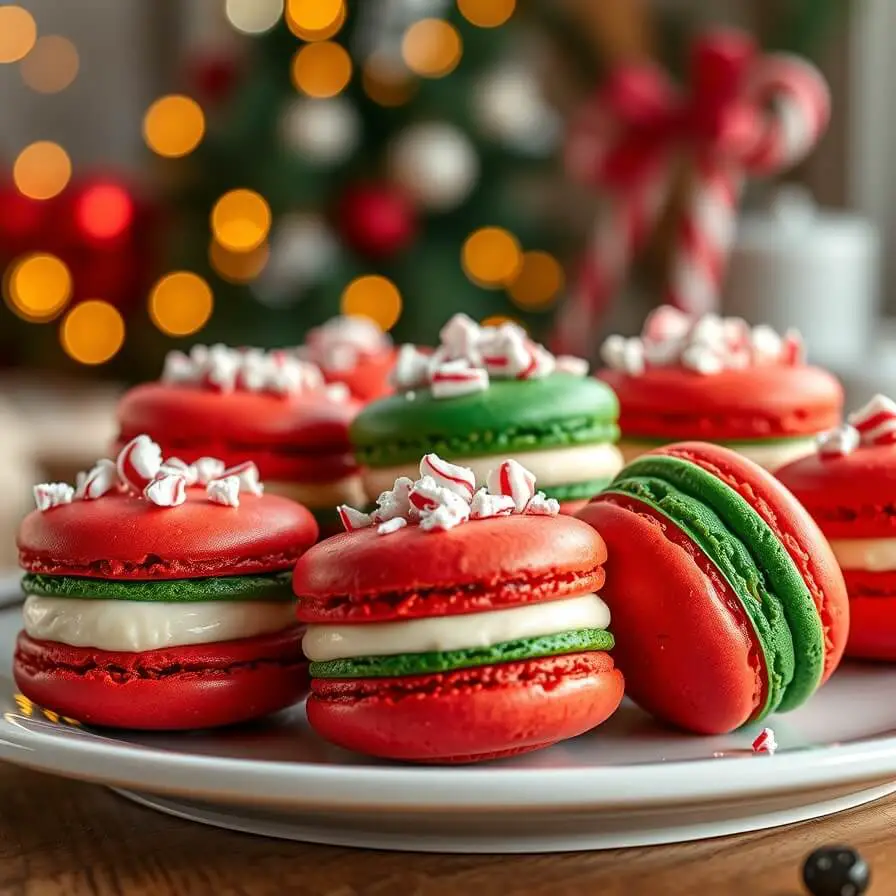
This is where the magic happens — and yes, it’s a little technical, but once you’ve done it once, you’ll feel like a pro.
Step – 1: Prepare your baking sheets and ingredients
Line two large baking sheets with parchment paper or silicone mats designed for macarons. Make sure your mixing bowls are completely grease-free (any oil will ruin the meringue). Sift your almond flour and powdered sugar together twice — this ensures a smooth texture for your shells.
Step – 2: Make the meringue
In a clean bowl, beat your egg whites on medium speed until foamy. Add the cream of tartar, then gradually add the granulated sugar, one tablespoon at a time. Increase to high speed and beat until you get stiff, glossy peaks — this usually takes about 5–6 minutes. If you lift the whisk, the peaks should stand up straight without collapsing.
Step – 3: Add color
Divide the meringue into two equal portions. Tint one half red and the other half green using gel food coloring. Use a spatula to gently fold until the color is evenly distributed — no streaks.
Step – 4: Macaronage (folding)
Now, gently fold the almond flour mixture into each meringue batch using a spatula. This is the most crucial step — overmix, and your batter will be too runny; undermix, and your shells will crack. The perfect batter should flow like lava — thick but smooth, forming ribbons that settle back into themselves within about 10 seconds.
Step – 5: Pipe the shells
Transfer each colored batter into separate piping bags fitted with round tips. Pipe 1½-inch circles onto your prepared baking sheets, spacing them about an inch apart. Tap the trays firmly on the counter a few times to release air bubbles. Pop any remaining bubbles with a toothpick for smooth tops.
Step – 6: Let them rest
This is the step that tests your patience — let the piped shells sit at room temperature for 30–45 minutes, until they form a thin, dry skin. When you gently touch the surface, it shouldn’t stick to your finger.
Step – 7: Bake
Preheat your oven to 300°F (150°C). Bake one sheet at a time for 15–18 minutes, rotating halfway through. The shells are done when they lift easily off the parchment but don’t brown.
Step – 8: Cool completely
Let the shells cool on the tray for about 10 minutes before removing them. Macarons are fragile when warm, so handle them gently.
Step – 9: Make the filling
Beat softened butter until fluffy, then gradually add powdered sugar and peppermint extract. If it’s too thick, add a tablespoon of cream or milk until smooth and creamy.
Step – 10: Assemble
Pair up the shells by size. Pipe a small dollop of buttercream onto the flat side of one shell, then gently sandwich it with another. If desired, roll the edges in crushed candy cane for extra holiday sparkle.
Substitutions
If you’re feeling creative or need to adjust for dietary preferences, there are a few easy substitutions that still make delicious results.
- Nut-free version: Swap almond flour for finely ground sunflower seed flour — it’s a great alternative that keeps the texture similar.
- Flavor swaps: Instead of peppermint, try orange zest and white chocolate for a creamsicle twist, or raspberry jam for a sweet-tart option.
- Dairy-free buttercream: Use a plant-based butter or coconut cream instead of dairy butter — just keep in mind that coconut adds its own mild flavor.
- Natural colors: If you prefer to avoid artificial coloring, you can use beet powder for red and matcha for green. The colors will be softer but still festive.
Sometimes, it’s these little changes that make the recipe uniquely yours. The joy of macarons lies in experimentation — once you’ve mastered the technique, the flavor combinations are endless.
Best Side Dishes for Christmas Macarons
Even though macarons are a dessert on their own, they pair beautifully with other holiday treats. When I serve them at Christmas gatherings, I like to build a small dessert board with a few complementary bites.
Here are three perfect companions:
- Hot Chocolate with Whipped Cream – The rich warmth of cocoa balances the light, sweet crunch of macarons beautifully.
- Cranberry Shortbread Cookies – Their buttery texture and tangy flavor play nicely with the peppermint filling.
- Mini Cheesecake Bites – Creamy and rich, they add variety to your dessert spread without overshadowing the macarons.
Each bite brings a different texture and flavor — together, they turn dessert time into a festive experience.
Serving and Presentation Tips
The best part about making Christmas macarons—aside from eating them—is how stunning they look on a table. These cookies are small works of art, and with just a few thoughtful touches, they can become the highlight of your holiday dessert spread.
Here’s what I love to do when serving them:
First, I arrange the red and green macarons in alternating colors on a white porcelain platter or a wooden serving board lined with parchment. The contrast makes the colors pop beautifully. Sometimes, I even dust the platter lightly with powdered sugar to mimic snow—it gives the whole display a wintery charm.
If I’m gifting them, I tuck them into small clear treat boxes with gold ribbons and a sprig of rosemary or a mini candy cane on top. They look like something straight out of a boutique bakery, but they’re entirely homemade.
For holiday parties, you can also build a macaron tower—stack them in a cone shape using a foam cone and toothpicks. It’s a centerpiece that doubles as dessert.
Remember: the key to presentation is keeping it simple but thoughtful. These macarons already carry the Christmas spirit in their colors and flavor—your goal is just to frame that beauty.
Tips and Tricks to Make This Recipe Even Better
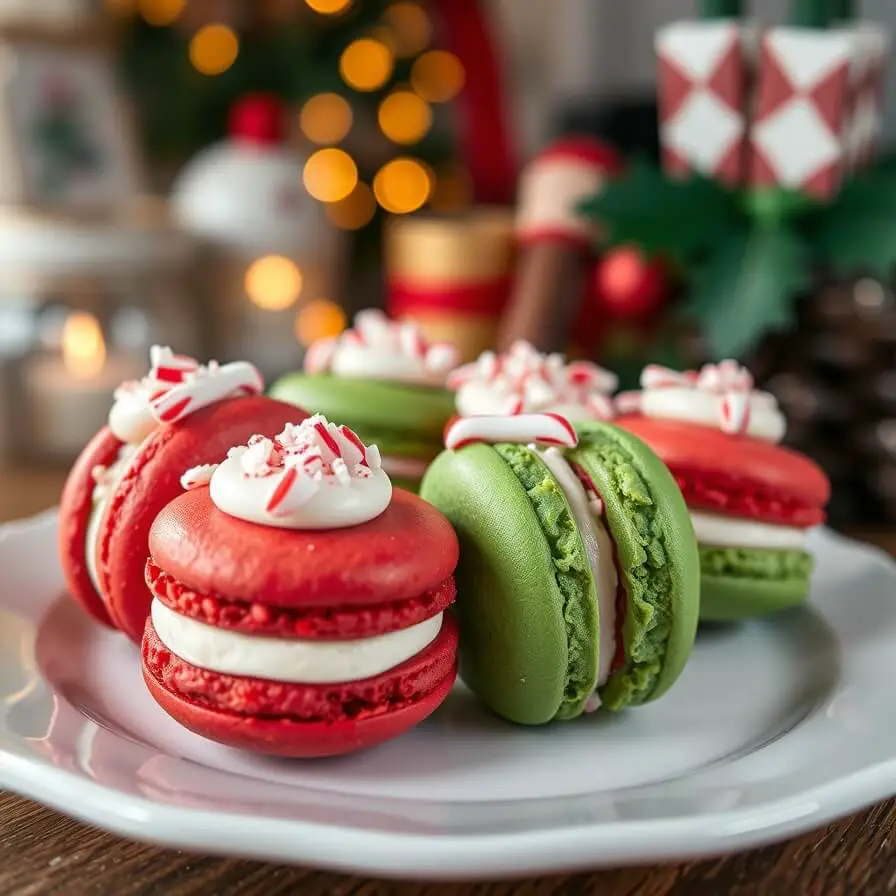
Making macarons feels a little like a science experiment at first, but with a few insider tricks, you can turn it into second nature. Here are the things I’ve learned over time (often the hard way):
1. Age your egg whites.
This one small step makes a huge difference. Letting your egg whites sit uncovered in the fridge overnight helps remove moisture, which makes for a stronger, more stable meringue.
2. Sift, sift, and sift again.
It might seem unnecessary, but double-sifting your almond flour and powdered sugar ensures silky-smooth shells. Any lumps can cause cracks or uneven tops.
3. Don’t rush the resting time.
If your shells don’t form that dry skin before baking, they’ll crack. I like to test by gently touching the top—if it doesn’t stick, they’re ready for the oven.
4. Bake one tray at a time.
Oven temperature consistency is key. Baking one tray ensures even airflow and prevents underbaking.
5. Let them mature.
Once filled, let the macarons sit in the fridge for at least 24 hours. This allows the shells to absorb some of the filling’s moisture, creating that signature chewy center.
6. Use an oven thermometer.
Most ovens run a little hot or cold. A thermometer ensures you’re truly baking at 300°F.
It’s amazing how these small adjustments can take your macarons from “pretty good” to “professional bakery” quality.
Common Mistakes to Avoid
Ah, macarons — the divas of the dessert world. They’re beautiful but unforgiving. I’ve made every mistake in the book, so here’s a list to save you from frustration.
Overmixing the batter
This is probably the number one issue. When you fold your almond mixture into the meringue, stop as soon as it flows like thick lava. If it’s too runny, the shells will spread too much and lose their shape.
Skipping the resting period
If you bake macarons too soon, the tops will crack and won’t develop those pretty feet. The resting time is non-negotiable.
Using liquid food coloring
Liquid coloring changes the texture of the batter and can cause deflation. Always stick to gel or powder.
High humidity
Macarons hate humidity. If it’s a damp day, try turning on your air conditioner or dehumidifier before baking.
Underbaking
If the shells stick to the parchment or feel gooey underneath, they need more time. Bake until they lift cleanly and the bottoms are set.
Once you’ve learned these lessons, you’ll find making macarons becomes more of a joyful ritual than a stressful science.
How to Store It
Macarons are best when they’ve had time to rest, but storing them properly is key to keeping their texture just right.
Once assembled, place the macarons in an airtight container, separating each layer with parchment paper to prevent sticking. Refrigerate for up to 5 days. They’ll actually taste better after the first 24 hours when the filling softens the shells slightly.
If you want to make them ahead for a party or gift, you can also freeze them. Lay them flat in an airtight container and freeze for up to 2 months. To thaw, move them to the refrigerator for a few hours—never thaw them at room temperature, or condensation can make the shells sticky.
FAQ
Q: My macarons cracked—what did I do wrong?
A: Most likely, you didn’t let the shells rest long enough before baking, or your oven temperature was too high. Always give them at least 30–45 minutes of drying time.
Q: How do I know when my meringue is ready?
A: You’ll know it’s ready when the peaks stand up straight and glossy without drooping. It should hold its shape when you lift the whisk.
Q: Can I make these without almond flour?
A: Yes! You can substitute sunflower seed flour in a 1:1 ratio. The texture and flavor are nearly identical, and it’s a great nut-free option.
Q: Can I make the buttercream ahead of time?
A: Absolutely. You can store it in the fridge for up to a week. Let it come to room temperature and re-whip before using.
Q: Why are my macarons hollow inside?
A: That’s usually from over-whipping the meringue or baking at too high a temperature. Try lowering your oven temperature by 10°F next time.

Christmas Macarons Recipe
- Total Time: 2 hours 15 minutes
- Yield: 25 1x
- Diet: Vegetarian
Description
A light, festive macaron with a peppermint buttercream filling that tastes just like Christmas. These delicate almond cookies feature a crisp shell, a chewy center, and creamy frosting—perfect for gifting, serving at parties, or enjoying by the fire with hot cocoa. With simple step-by-step instructions, even first-time bakers can create a bakery-worthy treat right at home.
Ingredients
1. Macaron Shells:
- 1 cup almond flour
- 1 ¾ cups powdered sugar
- 3 large egg whites (aged)
- ¼ cup granulated sugar
- ¼ tsp cream of tartar
- Red and green gel food coloring
2. Peppermint Buttercream:
- ½ cup unsalted butter, softened
- 1 ½ cups powdered sugar
- ½ tsp peppermint extract
- 1–2 tbsp heavy cream or milk
- Crushed candy canes (for garnish)
Instructions
- Sift almond flour and powdered sugar twice for a smooth texture.
- Beat egg whites with cream of tartar until foamy, then slowly add granulated sugar. Whip until stiff peaks form.
- Divide and color meringue red and green using gel coloring.
- Fold almond mixture into meringue until batter flows like lava.
- Pipe 1½-inch rounds onto lined baking sheets. Tap to remove air bubbles.
- Let rest 30–45 minutes until tops are dry to touch.
- Bake at 300°F (150°C) for 15–18 minutes, one tray at a time.
- Cool completely before removing.
- For buttercream: beat butter, powdered sugar, and peppermint extract until fluffy. Add cream if needed.
- Sandwich shells with buttercream, then roll edges in crushed candy cane.
- Chill for 24 hours before serving for best texture.
Notes
- Always use gel food coloring to maintain the perfect batter consistency.
- Humidity can ruin macarons—bake in a cool, dry environment when possible.
- Aging the egg whites overnight helps create a stable meringue and perfect “feet.”
- Prep Time: 40 minutes
- Cook Time: 18 minutes
- Category: Dessert
- Method: Baking
- Cuisine: French
Nutrition
- Serving Size: 25
- Calories: 95
- Sugar: 12g
- Sodium: 15mg
- Fat: 4.5g
- Saturated Fat: 2.5g
- Unsaturated Fat: 1.5g
- Trans Fat: 0g
- Carbohydrates: 12g
- Fiber: 0.5g
- Protein: 2g
- Cholesterol: 10mg

